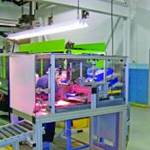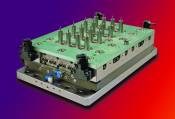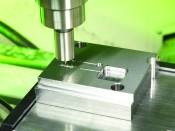Gain Access to the Recession-Proof Medical Market
Moldmakers who want to diversify into medical—or maintain their competitive edge—need up-to-date, high-tech engineering and fabrication capabilities in order to meet the toolmaking industry’s most stringent quality standards.
Moldmakers will find growing opportunities in the medical market as product demand, especially in disposables, maintains solid growth for the foreseeable future.
Factors affecting this include demographic trends that point toward an older population and increasing numbers of the elderly, along with the social and economic benefits of healthier lifestyles and the devices that go along with that, more home healthcare treatments and growing numbers of chronic-care patients who will be treated in hospitals and rehabilitation centers.
According to figures from The Freedonia Group Inc. (Cleveland, OH), the value of the U.S. medical market will post 8% average annual growth through 2016. Demand for medical products will rise to $575 billion in 2011 from $412 billion in 2006, and to $800 billion in 2016. Leading end-use markets include disposables—a broad category ranging from pipettes and syringes to wound-management supplies and nonwovens—which will account for 12.2% of medical products in 2011 and 10.9% in 2016. Though the 2016 figure is a 10.6% decline, it is based on a market that is predicted to increase by 39% during that period.
Growth Means Competition
As the market grows, however, it will attract moldmakers who are looking to diversify as a way of remaining competitive and profitable. The well-documented problems of the Big Three automakers and prospects for a downsizing of their operations, for example, are likely to push many mold shops that specialize in automotive to markets like medical where their advanced mold engineering and fabrication capabilities are a good fit.
“There will be more competition for everything that’s not automotive,” says Dave Preston, President of toolmaker Accu-Mold Inc. (Portage, MI). In speaking about the U.S. automakers’ problems and the bad economy, Preston adds, “I would guess that there’s going to be another one-third dropout of tool and die makers from the industry—companies that haven’t diversified or are living entirely on automotive work. I see the strong getter stronger and the weak getting weaker.”
Toolmakers seeking an edge in the medical market have plenty of options available to improve their capabilities and stand apart from competitors. Equipment and component suppliers are providing a number of products that improve the accuracy, cycle time and versatility of medical injection molds.
Notable here is the continuing trend to size reduction in medical products. “Technology is driving design to smaller parts, thus the requirements for dimensional tolerances are becoming more critical,” says John Blundy, Vice President of Business Development at Incoe Corp. (Troy, MI).
One company specializing in components that improve process quality and enhance small-part production is Mold-Masters Ltd. (Georgetown, ON). The company offers a servo-actuated valve-gate system for tight pitches and small shots called Synchro Plate. Designed for mounting on the hot runner side of a mold, Synchro Plate, part of Mold-Masters’ E-Drive, assures that all valve pins open and close at the same time, says Bruce Catoen, Vice President of Marketing, Business and Product Development. This happens because all the valve pins in a mold are attached to the servo-driven Synchro Plate, rather than each pin being driven by a piston powered by air from a manifold.
In addition to consistent valve gating for all cavities, Catoen says another benefit of the Synchro Plate is that by eliminating pistons, moldmakers achieve tighter pitch spacing with nozzles. “Your limit on pitch becomes the nozzle as opposed to the piston.” The system permits a minimum pitch spacing of 18-21 mm. for nozzles, Catoen says.
The system was introduced at K2007, but relaunched at last October’s Fakuma show with a new feature—an automatic pin disconnect. Catoen says that adding a patented magnetic connection to the Synchro Plate lets a molder turn an individual drop off if a problem develops. Otherwise, he would have to run all cavities in a mold. Turning off one or more drops could affect the balance of a hot-runner system, Catoen admits, which would be critical in some parts. “But in a number of instances our customers can turn off drops and still make quality parts.”
High-Precision Valve Gates
In another development with application for precision medical molding, Mold-Masters unveiled an electric valve gate at last month’s Euromold show. Called EVG, the device generates almost two times the gate-closing power of a pneumatic valve pin, which virtually assures repeatable molding cycles. EVG, available in 55- and 75-mm. pitches, is also energy efficient, using about 0.14/kw./hr. of electricity compared with 1.5 for conventional systems. Catoen says this would translate to savings of about $900 per year on a four-cavity mold.
Another company with an electric valve gate is Husky Injection Molding Systems Ltd. (Bolton, ON). The electric synchronized valve stem actuation system also assures that all valve stems are actuated together, thereby preventing imbalance caused by some valve gates opening or closing too soon or too late.
Bill Gunn, Medical Market Manager, says that OEMs are paying closer attention to the cost of resins, scrap and operations. As a result, they are keen on any device that contributes to process savings. With its consistent valve-gating, the electric actuation system minimizes scrap, especially with small, thinwall parts. When paired with the company’s Ultra 350 valve gate, one of Husky’s smallest (resin throughput of 2-20 grams/sec.), pitch spacing of 18 mm. is achievable. This means OEMs that turn to higher-cavity molds to reduce production costs don’t necessarily have to invest in larger injection machines, since they may be able to hold down mold size with the Ultra 350 valve gate.
Husky has also developed a version of its Ultra 500 nozzle (throughputs to 20 grams/sec.), which Gunn says is designed for high-pressure molding that’s typical with thinwall parts. The new version of the Ultra 500 reportedly withstands 50,000 psi.
To meet clean room molding requirements as well as tight dimensional tolerances, medical molds are often fabricated of stainless steel and other hardened metals. In an effort to provide optimum machining of these metals during continuous operations that last 24 hours or more, Makino (Mason, OH) has upgraded its V33 hardmilling vertical machining center to improve its productivity. The new version, the V33i, is designed for metals with Rockwell hardness of 50 or more. The company has fine-tuned the spindle to increase stiffness and rigidity and minimize tool chatter, and improved the cooling system to reduce thermal growth and other heat-related problems that affect dimensional accuracy.
Standard on the V33i is a 20,000-rpm. spindle. Options include 30,000- and 40,000-rpm. spindles. The machine, which has a 450 X 750-mm. (18 X 30-in.) cutting table, can be equipped with a proprietary spindle-core cooling system that circulates chilled coolant through the spindle and bearings. Other features include core-cooled ball screws, lubricated ball nuts, servomotor cooling jacket and temperature-controlled passageways.
“We achieve better spindle accuracy because we attack sources of heat, rather than just look for ways of controlling it,” says Mark Rentschler, Marketing Manager.
Combined with integral, hardened guideways and heavy castings, the V33i machining center achieves peak motion performance with a range of tools while maintaining tight dimensional tolerances on complex shapes, Rentschler says.
LSR Projected to Grow
This is especially important when it comes to machining molds for liquid silicone rubber (LSR) parts. Rentschler notes that LSR, a thermoset, can be difficult to process. Moldmakers need to maintain high levels of dimensional accuracy to prevent flashing and precise shutoffs to prevent shrinkage. Rentschler says the precision of the V33i suits it for use on LSR molds.
LSR has always had a place in the North American medical market, though it’s more widely used in Europe and elsewhere. Some experts believe, however, that LSR—and LSR molds—will make strong gains as medical OEMs tap its inherent properties of chemical inertness and sealability, elastomeric features and soft touch for a range of products. Some forecasts call for 10-15% total growth in LSR consumption in North America in coming years.
Component supplier D-M-E Co. (Madison Heights, MI) is selling a standardized valve-gate system for LSR molds called Cold Deck. The product has been available in Europe for some time, where more than 600 are in the field, but was brought to North America last year in anticipation of greater demand for LSR parts, says Mike Kreitner, Business Manager for Quick-Change Mold Systems and Emergent Technologies.
Kreitner says that one strength of the Cold Deck system is its standardized components, which can be purchased off-the-shelf and maintained more easily than if they were custom. The system, which has a quick-clamp mechanism, also permits interchanging of cavities and cores, a benefit that contributes to a project’s overall economy and which can make molders more competitive. Instead of building one Cold Deck system for one mold, a system can be used with different cavities and cores, as long as they are in the same X, Y, Z configurations as the original cavities. It’s a feature that has to be designed into a mold, but the “Cold Deck can be used over many different part configurations,” he says.
Different part configurations, moreover, would not need to have the same shot volume, due to the fact that LSR cures in a mold and is not as temperamental in terms of residence time as thermoplastics.
For now, the product is sized for molds with up to 32 drops, though this will probably increase in the future. Cold Deck nozzles accommodate shot sizes starting at less than 1 ounce.
Versatile Hot Runners
D-M-E is offering a similar feature with an upgraded version of its Stellar thermoplastic hot-runner system. It has redesigned the hot runners, which come in 27 manifold and pitch layouts, into standard (commodity resins) and high-performance (engineering and high-heat resins) versions that are now called Stellar 5000. These hot runners are designed to fit easily into the company’s Master Unit Die systems and accept material changes as long as the right hot-runner version is used and the new cavity inserts match nozzle pitch, says Bob Ameel, Global Business Manager for Hot-Runner Systems.
“This permits different parts with similar shot weights to be run with one hot-runner system.”
Stellar 5000 hot runners are for part weights of 1-20 grams.
D-M-E also introduced on Dec. 1 a heater for use with the standard hot runner and one for the high-performance version, along with new tips that are designed to enhance resin flow.
The large proportion of disposable medical parts raises the same issues of waste disposal and sustainability that other large-volume industries face. One way to meet “green” part requirements is with the use of bioresins like those made from polylactic acid (PLA). These materials have different flow characteristics, which means mold components like hot runners need to be adapted for their use. D-M-E has developed a hot-runner system called Ecosmart, which is for use with compostible or biodegradable resins, including PLA.
Ameel says the company has specified a different grade of steel for the hot runner and designed nozzles to address the flow and molding challenges these resins present. Ecosmart comes in four nozzle sizes—A lengths of 45, 50, 65 and 70 mm.—and 1.25-inch center-to-center pitch dimensions. Shot weights run from 20-120 grams, depending on tip geometry. The hot runner will be formally introduced during the first quarter.
Incoe has developed a hot runner system that Blundy says resolves problems of resin imbalance in filling multicavity molds. The company achieved this by eliminating “steel-induced inconsistencies” in cavity designs and nozzles. The result is nozzles and manifolds that are verified by thermal imaging to “ensure uniform heat profiles.”
Incoe also partnered with Beaumont Technologies Inc. (Erie, PA), a specialist in melt delivery systems, to deal with shear-induced filling imbalances in hot runners. “Resolving filling imbalances provides injection molders with dimensional stability, physical property consistency and the potential for cycle time reduction due to a wider process window,” Blundy says.
Other components are being designed to meet the demands of medical molding, notably long life, clean operation and compact size. Progressive Components (Wauconda, IL) has at least three that are suitable for medical molds, according to Al Hickok, Midwest sales manager.
One is the Slide Retainer, part of the Friction Free line, which maintains a mold’s side actions. The compact component has a roller that fits into a groove within a side-action assembly. Its spring mechanism withstands millions of cycles, Hickok says. The device is compact, which makes it easy to machine and integrate within a mold, yet it supports more weight than most competitive retainers.
Another product in the line is the Needle Bearing Lock, which helps realign molds to prevent flash and achieve complicated shutoffs. The lock provides smooth, consistent positioning and precise registration between the mold halves, Hickok says, and shows virtually no wear after 1 million cycles.
The third product, UltraPin, is ideal for clean-room molding, Hickok reports, as it’s a chrome-plated ejector pin that needs no lubrication, and thus will not introduce contaminants to a protected molding environment.
Summary
One supplier says that medical is a strategic market for his company, since even in a recession, it’s one of the few industries with opportunities for growth. “People will continue to eat, drink and get sick,” he notes, “so medical, along with personal care and packaging, is a very attractive market to invest in.”
It is indeed attractive. But in the current business environment, opportunities mean competition. Moldmakers who want to maintain their edge in medical, or diversify by expanding into it, need the high-tech engineering and fabrication capabilities necessary to meet some of the toolmaking’s most stringent quality standards.
This is not a market for companies that aren’t on the leading edge of technology, or which haven’t learned how to work faster, better and more productively. Medical is a challenge, but one worth taking. Those who succeed will have plenty to show for it in business and profitability.
For more information from Patrick A. Toensmeier e-mail toensmeier@ sbcglobal.net or visit www.moldmakingtechnology.com.
Related Content
Mold Design Review: The Complete Checklist
Gerardo (Jerry) Miranda III, former global tooling manager for Oakley sunglasses, reshares his complete mold design checklist, an essential part of the product time and cost-to-market process.
Read MoreThe Role of Social Media in Manufacturing
Charles Daniels CFO of Wepco Plastics shares insights on the role of social media in manufacturing, how to improve the “business” side of a small mold shop and continually developing culture.
Read MoreThe Critical Role of Management Representatives in ISO 9001
In ISO 9001 quality management systems, the Management Representative (MR) plays a crucial role. While the 2015 version of ISO 9001 no longer mandates this position, having a trusted management member serve as an MR remains vital for streamlining operations and maintaining quality standards.
Read MoreSteps for Determining Better Mold Prices
Improving your mold pricing requires a deeper understanding of your business.
Read MoreRead Next
Moldmaking Skills Give Mar-Lee a Business Boost
Molder taps tool building skills to maintain double-digit growth in high end of the market.
Read MoreReasons to Use Fiber Lasers for Mold Cleaning
Fiber lasers offer a simplicity, speed, control and portability, minimizing mold cleaning risks.
Read MoreHow to Use Strategic Planning Tools, Data to Manage the Human Side of Business
Q&A with Marion Wells, MMT EAB member and founder of Human Asset Management.
Read More























